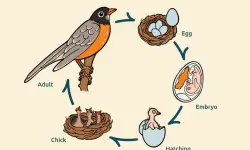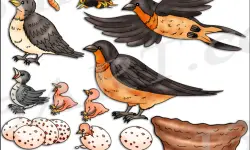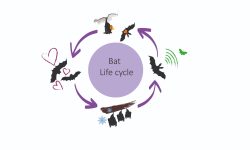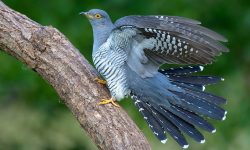Introduction: Uncovering Hawaii’s Rare Cuckoo Visitors
Hawaii, known for its tropical beauty and rich birdlife, is not usually associated with cuckoos. These secretive, sometimes elusive birds are better known in continents like Asia, Europe, and the Americas. However, a surprising number of cuckoo species have been spotted in the Hawaiian Islands, mostly as rare migrants or vagrants blown off course during long-distance journeys. From the melodious Common Cuckoo to the striking Channel-billed giant, these appearances add a mysterious, global flavor to Hawaii’s avian landscape. This article explores eight cuckoo species recorded in Hawaii, complete with key identification tips and insights into their status.
1. Common Cuckoo (Cuculus canorus)

Identification
The Common Cuckoo is a master of deception and sound, often heard before it is seen. At first glance, it could be mistaken for a small raptor—the resemblance is no accident. With slate-gray upperparts, finely barred white-and-black underparts, long tail feathers edged with white, and sharply pointed wings, it glides with the elegance of a hawk. A piercing yellow eye-ring gives it an intense, alert expression. But it is the voice of the cuckoo that truly defines it—haunting and unmistakable, echoing across European meadows and Asian forests like a signal from the wild. The male’s two-note call, “cu-coo,” is so iconic that it has inspired everything from clockmakers to poets for centuries.
Status in Hawaii
Though a symbol of spring across Eurasia, the Common Cuckoo’s presence in Hawaii is fleeting and rare—yet remarkable. A handful of records exist from Oʻahu and Kauaʻi, where the bird is believed to arrive as a trans-oceanic vagrant. Likely swept off course by strong typhoons or driven by instinctual wanderlust, these wayward travelers represent the species’ astonishing capacity for long-distance flight. Their unexpected appearance in the Pacific tropics creates a moment of awe for birders—an echo of distant forests calling from halfway around the world.
Behavior and Ecological Role
What makes the Common Cuckoo particularly fascinating—beyond its voice and flight—is its breeding strategy. Unlike most birds, the cuckoo lays its eggs in the nests of other species, often mimicking the color and pattern of the host’s eggs to avoid detection. This form of brood parasitism is rare in Hawaii’s avian world, making the cuckoo’s presence even more intriguing. Although it does not breed on the islands, its occasional visits bring with them an evolutionary story that contrasts sharply with Hawaii’s mostly self-contained, co-evolved bird communities. Each sighting becomes a reminder of nature’s unpredictability and the astonishing adaptability of this enigmatic bird.
2. Yellow-billed Cuckoo (Coccyzus americanus)

Identification
Graceful and slender, the Yellow-billed Cuckoo cuts a quiet figure in the woodlands of North America. This medium-sized cuckoo is instantly recognizable by its long, graduated tail boldly patterned with large white spots underneath, and its warm cinnamon-brown upperparts contrasting with a clean white belly. The bird’s namesake is its slightly downcurved bill—black on top and yellow below—which gives it a soft but alert expression. Typically shy and retiring, the Yellow-billed Cuckoo often goes unnoticed as it slips through dense foliage in search of caterpillars and insects, moving slowly and deliberately with a near-silent presence.
Status in Hawaii
While common in eastern and central parts of the continental U.S. during breeding season, the Yellow-billed Cuckoo is an exceedingly rare visitor to Hawaii. One of the most astonishing records comes from remote Laysan Island in the Northwestern Hawaiian chain—a tiny coral atoll over 800 miles from the main islands. The appearance of this species so far from its usual range suggests a case of extreme vagrancy, likely due to strong storm systems or navigational error during migration. Its presence in such an isolated and ecologically fragile location underscores the power of wind and instinct in driving birds across unimaginable distances.
Behavior and Ecological Significance
Nicknamed the “Rain Crow” for its tendency to call before storms, the Yellow-billed Cuckoo is a stealthy insectivore with a particular appetite for large, hairy caterpillars that other birds avoid. In its native range, this species plays a vital ecological role by helping control outbreaks of defoliating insects like tent caterpillars. Though it does not breed in Hawaii, its occasional appearances offer a glimpse into a bird built for both stealth and endurance. Its secretive habits and long-distance abilities make each Hawaiian sighting a thrilling surprise—one that ties the remote Pacific islands to the rhythms of mainland migration and atmospheric forces far beyond their shores.
3. Pacific Long-tailed Cuckoo (Urodynamis taitensis)

Identification
Striking and powerful in flight, the Pacific Long-tailed Cuckoo is one of the most impressive and wide-ranging cuckoo species of the South Pacific. This large bird is dressed in mottled brown plumage speckled with pale spots, helping it blend seamlessly into dense forest canopies. Its most distinctive feature is its long, expressive tail, which trails behind like a rudder during agile flights. With a sharp, hawk-like silhouette and piercing yellow eyes, it can easily be mistaken for a bird of prey. Yet it is the call—a series of loud, whistling cries echoing through the forest—that often gives it away, earning it an almost mythical presence in the Polynesian landscape.
Status in Hawaii
Though not a regular visitor, the Pacific Long-tailed Cuckoo occasionally appears in the Hawaiian Islands during the austral winter, which corresponds to summer in the Northern Hemisphere. These rare sightings are believed to involve individuals dispersing northward after breeding in New Zealand or nearby Pacific islands such as Fiji or Tonga. Their arrival is likely aided by seasonal winds and migratory instinct, making their presence in Hawaii a compelling example of natural navigation across vast ocean distances. Such occurrences are extremely scarce, but they link the biodiversity of Hawaii to the broader migratory networks of the southern Pacific.
Behavior and Ecological Significance
Unlike some cuckoos, the Pacific Long-tailed Cuckoo is a specialist brood parasite, particularly known for targeting the nests of whiteheads (Mohoua albicilla) in New Zealand. It lays its eggs secretly and leaves the host species to raise its chick, which often outcompetes the original offspring. This strategy, while controversial from a human perspective, is a sophisticated evolutionary adaptation that has allowed the species to thrive across islands with limited nesting seasons. In Hawaii, the bird does not breed, but its rare appearances hint at an ecological life shaped by long journeys, tropical archipelagos, and complex interspecies dynamics. Its story is one of endurance, stealth, and a deep connection to the rhythms of Oceania.
4. Channel-billed Cuckoo (Scythrops novaehollandiae)

Identification
Towering above all its relatives, the Channel-billed Cuckoo holds the title of the world’s largest cuckoo. With a wingspan stretching over a meter, this imposing bird has pale gray plumage, striking red eyes, and a formidable, down-curved bill reminiscent of a hornbill’s—giving it an unmistakable silhouette. Long, broad wings and a deep tail enhance its heavy, deliberate flight, often accompanied by a loud, croaking call that echoes through tropical canopies. Despite its size, the Channel-billed Cuckoo is surprisingly agile among the treetops, moving with purpose as it searches for fruit and nesting opportunities.
Status in Hawaii
While this species is native to Australia, New Guinea, and surrounding islands, it has made a handful of rare appearances in Hawaii. These occurrences are believed to result from powerful weather systems, such as cyclones or typhoons, which can push birds far beyond their expected range. Sightings in Hawaii, though few, are confirmed and remarkable—given the bird’s size, tropical origin, and limited flight endurance compared to more aerodynamic migrants. Each record suggests the vast reach of storm-driven vagrancy and highlights Hawaii’s role as an occasional landing zone for even the most unlikely travelers.
Behavior and Ecological Significance
In its native range, the Channel-billed Cuckoo is an obligate brood parasite, primarily targeting large corvids such as crows and currawongs. Unlike smaller cuckoos, which often rely on stealth and mimicry, this species lays its eggs openly, sometimes with the aid of its host species’ cooperative behavior. Its diet is also unusual among cuckoos—heavily frugivorous, it plays an important role in seed dispersal in Australia’s subtropical forests. In the context of Hawaii, the bird’s appearances are too rare to have any ecological impact, but they serve as a dramatic example of avian wanderlust. With its prehistoric appearance and transoceanic reach, the Channel-billed Cuckoo stands as a true anomaly—a ghost from the Australasian canopy carried by wind into the heart of the Pacific.
5. Mangrove Cuckoo (Coccyzus minor)

Identification
Elegant and elusive, the Mangrove Cuckoo is a master of concealment. It wears a subtle but refined palette—soft gray upperparts blending into warm, buff-colored underparts, all set off by a bold black eye-stripe that cuts across the face like a thief’s mask. Its bill is thick and slightly down-curved, dark above and pale below, built for probing dense tangles of vegetation. Though similar in size and structure to its relatives, the Mangrove Cuckoo is less often seen, preferring to stay deep within coastal thickets where it moves with quiet precision.
Status in Hawaii
In Hawaii, this species is one of the rarest cuckoos ever recorded—if indeed it has been recorded at all. Only a handful of sightings exist, many of them unconfirmed or considered hypothetical. These reports are tantalizing, suggesting that individuals may have been pushed far off course by tropical storms or hurricanes that swept across the Caribbean or Gulf of Mexico. Native to mangrove forests from southern Florida through the Caribbean and into Central America, the Mangrove Cuckoo is tightly tied to coastal ecosystems. Its appearance in Hawaii, if verified, would represent an extraordinary instance of transoceanic displacement.
Behavior and Ecological Significance
In its native range, the Mangrove Cuckoo is a quiet inhabitant of salt-tolerant forests and brackish coastal zones. It feeds primarily on large insects, caterpillars, and small reptiles, and while it is not a brood parasite like some of its cousins, it remains notoriously difficult to study due to its retiring nature. The species is highly territorial, often vocalizing with low, guttural croaks or soft “kow-kow-kow” calls that echo eerily through humid mangrove tunnels. Though it plays little to no ecological role in Hawaii due to its rarity, the Mangrove Cuckoo’s potential arrival—however brief—speaks to the unpredictability of avian dispersal and the hidden movements of birds that often go unseen, even in plain sight.
6. Shining Bronze-Cuckoo (Chrysococcyx lucidus)
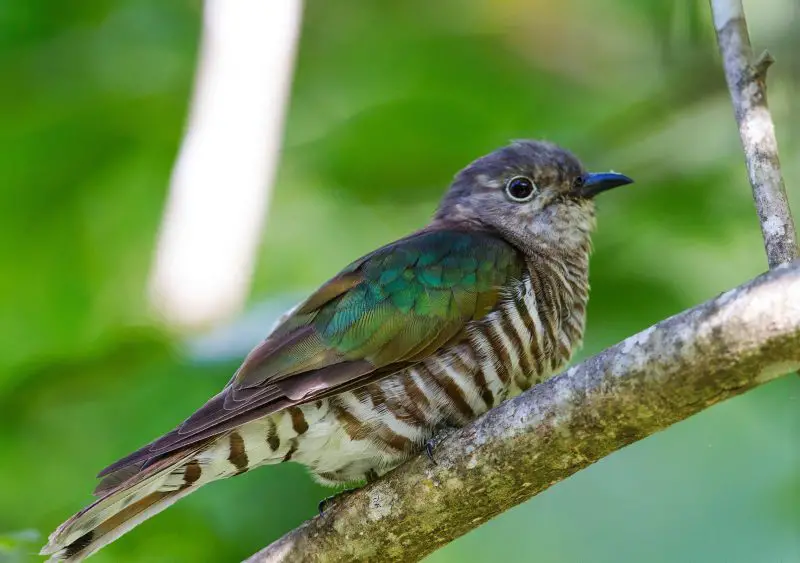
Identification
Gleaming like a flying emerald, the Shining Bronze-Cuckoo is a tiny bird with dazzling plumage that belies its secretive habits. Its upperparts flash with an iridescent green sheen that shimmers in sunlight, while its underparts are pale with fine, dark barring. Delicate yet vivid, it has a short, fine bill and a relatively long tail for its size. Despite its brilliance, it is often hard to spot in the forest canopy, where it moves quietly among the leaves. When it does reveal itself, its glinting feathers and sharp, high-pitched call give it away instantly—an unmistakable spark of Australasia.
Status in Hawaii
Though native to New Zealand, Australia, and nearby islands, the Shining Bronze-Cuckoo occasionally finds its way to Hawaii as a rare vagrant. These sightings are typically associated with powerful southerly storm systems, which can carry small migratory birds vast distances across the Pacific. Its appearance in the Hawaiian Islands is fleeting and unpredictable, usually limited to single individuals observed on the larger islands. Still, each record adds to Hawaii’s reputation as a remote outpost for avian wanderers caught in the great aerial currents of the Southern Hemisphere.
Behavior and Ecological Significance
The Shining Bronze-Cuckoo is a brood parasite, particularly targeting small insectivorous birds like gerygones and thornbills in its native range. It lays a single egg in the host’s nest, and the resulting chick will often eject the host’s young—an evolutionary strategy as ruthless as it is effective. Despite its small size, the bird undertakes long-distance migrations between New Zealand and Australia, making its rare dispersal to Hawaii even more impressive. Insects, especially caterpillars, form the bulk of its diet, including species covered in toxic hairs that most birds avoid. Though it does not breed in Hawaii, its rare presence offers a fleeting glimpse of one of the Southern Hemisphere’s most beautiful and enigmatic cuckoos—living proof that even the smallest travelers can cross oceans.
7. Fan-tailed Cuckoo (Cacomantis flabelliformis)

Identification
Elegant and slightly mysterious, the Fan-tailed Cuckoo is a medium-sized bird cloaked in soft, grayish-brown plumage that gives it a subdued yet refined appearance. Its most distinctive features are a bold yellow eye-ring that stands out against its muted face and a broad, rounded tail that fans open in display or flight—hence its name. When perched, it often flicks its tail subtly, as if testing the breeze. Its call is unmistakable: a rising, then descending trill that seems to melt into the forest air, often echoing through eucalyptus groves and temperate woodlands in its native range.
Status in Hawaii
Though native to Australia, New Guinea, and parts of Southeast Asia, the Fan-tailed Cuckoo has made rare appearances in Hawaii, most likely as a result of post-breeding dispersal. These records are few and scattered, but credible. Individuals may arrive during seasonal wanderings or be caught in strong prevailing winds that push them across the Pacific. The most likely arrival points are the main Hawaiian Islands, where isolated sightings occasionally spark excitement among birders. Though it does not breed or stay long, its presence represents yet another example of Hawaii’s open skies attracting unlikely travelers.
Behavior and Ecological Significance
Like many cuckoos, the Fan-tailed Cuckoo practices brood parasitism, typically targeting small insectivorous birds such as fairy-wrens and thornbills in its home regions. Its eggs often mimic the color of the host’s, helping them go undetected. The chick, once hatched, grows rapidly—often outcompeting or even ejecting the host’s young. The adult cuckoo feeds mostly on insects and their larvae, with a preference for caterpillars, including hairy or toxic species avoided by other birds. Although it plays no ecological role in Hawaii due to its rarity, its occasional presence is a striking reminder of how even the most distant islands are connected by vast, unseen aerial corridors. Every appearance of this understated traveler whispers of wild, transoceanic journeys and the resilience of instinct.
8. Oriental Cuckoo (Cuculus optatus)

Identification
Closely resembling the more familiar Common Cuckoo, the Oriental Cuckoo is a subtle twin—best distinguished by those who know what to listen and look for. It typically appears slightly more compact, with darker plumage and heavier barring on its pale underparts. The tail is long and rounded, the wings sharply pointed, and the eyes encircled with a narrow yellow ring. In the field, separating it from the Common Cuckoo is challenging, but the vocalizations are key: the Oriental Cuckoo produces a softer, more bubbling series of hoots rather than the iconic “cu-coo” call. In silent individuals, differences in size, structure, and barring must be carefully scrutinized—making this species a real challenge even for experienced birders.
Status in Hawaii
Though not officially confirmed with photographic evidence, the Oriental Cuckoo is considered a potential vagrant in the Hawaiian Islands. Its broad migratory range, spanning from Siberia and northeastern Asia to Southeast Asia and even northern Australia during winter, brings it well within reach of the Pacific jet stream. The species has been recorded as a rare stray across Micronesia and other island groups, suggesting a real, if unlikely, chance of arrival in Hawaii—especially during seasonal migration or post-breeding dispersal events. Any confirmed sighting would be an extraordinary addition to Hawaii’s avifauna.
Behavior and Ecological Significance
The Oriental Cuckoo, like many in its genus, is a brood parasite, targeting small passerines such as warblers and flycatchers. Its eggs closely mimic those of its host species, allowing the developing chick to be raised undetected. The young cuckoo often outgrows and outcompetes its foster siblings within days of hatching. In its breeding range, it plays a nuanced role in shaping host bird behavior and reproductive strategies—pushing them to evolve better egg-recognition and nest-defense tactics. While it does not breed in Hawaii, even a single sighting would offer valuable insights into the species’ dispersal capabilities and the global reach of migratory birds. The Oriental Cuckoo’s elusive nature and resemblance to its cousins make it one of the most intriguing and challenging cuckoos a birder might hope to encounter—anywhere on Earth.
Conclusion: Elusive Visitors Worth Watching For
Though none of these cuckoo species are resident breeders in Hawaii, their occasional appearances provide a window into the vast migratory journeys birds can undertake. Spotting a cuckoo in Hawaii is a rare thrill—part mystery, part miracle. As global weather patterns shift and bird movements respond, who knows which rare visitor might turn up next? For birders and nature lovers alike, these cuckoos are a reminder that even in the middle of the Pacific, the world’s avian wonders can still come calling.

